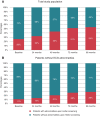An evaluation of 24 h Holter monitoring in patients with myotonic dystrophy type 1
- PMID: 35851806
- PMCID: PMC9907751
- DOI: 10.1093/europace/euac104
An evaluation of 24 h Holter monitoring in patients with myotonic dystrophy type 1
Abstract
Aims: To evaluate the clinical effectiveness of routine 24 h Holter monitoring to screen for conduction disturbances and arrhythmias in patients with myotonic dystrophy type 1 (DM1).
Methods and results: A retrospective two-centre study was conducted including DM1-affected individuals undergoing routine cardiac screening with at least one 24 h Holter monitoring between January 2010 and December 2020. For each individual, the following data were collected: Holter results, results of electrocardiograms (ECGs) performed at the same year as Holter monitoring, presence of cardiac complaints, and neuromuscular status. Holter findings were compared with the results of cardiac screening (ECG + history taking) performed at the same year. Cardiac conduction abnormalities and/or arrhythmias that would have remained undiagnosed based on history taking and ECG alone were considered de novo findings. A total 235 genetically confirmed DM1 patients were included. Abnormal Holter results were discovered in 126 (54%) patients after a mean follow-up of 64 ± 28 months in which an average of 3 ± 1 Holter recordings per patient was performed. Abnormalities upon Holter mainly consisted of conduction disorders (70%) such as atrioventricular (AV) block. Out of 126 patients with abnormal Holter findings, 74 (59%) patients had de novo Holter findings including second-degree AV block, atrial fibrillation/flutter and non-sustained ventricular tachycardia. Patient characteristics were unable to predict the occurrence of de novo Holter findings. In 39 out of 133 (29%) patients with normal ECGs upon yearly cardiac screening, abnormalities were found on Holter monitoring during follow-up.
Conclusion: Twenty-four hour Holter monitoring is of added value to routine cardiac screening for all DM1 patients.
Keywords: Ambulatory monitoring; Electrocardiogram; Holter monitoring; Myotonic dystrophy; Neuromuscular disease.
© The Author(s) 2022. Published by Oxford University Press on behalf of the European Society of Cardiology.
Conflict of interest statement
Conflict of interest: B.G.M.V.E. reports grants from Spieren voor Spieren, grants from Prinses Beatrix Spierfonds, grants from Dutch FSHD foundation, grants from Marigold foundation, grants from Netherlands Organisation for Scientific Research (NWO), grants from The Netherlands Organisation for Health Research and Development (ZonMw), grants from Association Francaise contre les Myopathies, grants and personal fees from Fulcrum, personal fees from Facio, personal fees from Arrowhead, all payed to the institution and outside the submitted work. C.G.F. reports grants from European Union’s Horizon 2020 research and innovation programme Marie Sklodowska-Curie grant for PAIN-Net, molecule-to-man pain network (grant no. 721841), grants from Grifols and Lamepro for a trial on IVIg in small fibre neuropathy, grants from Prinses Beatrix Spierfonds, Steering committtees/advisory board for studies in small fibre neuropathy of Biogen/Convergence, Vertex, Lilly and OliPass, outside the submitted work. K.V. reports grants from Medtronic, Abbott and Biotronik, and a consultancy agreement with Medtronic, outside the submitted work. All remaining authors have declared no conflicts of interest.
Figures


Similar articles
-
Twenty-four-hour ambulatory ECG monitoring relevancy in myotonic dystrophy type 1 follow-up: Prognostic value and heart rate variability evolution.Ann Noninvasive Electrocardiol. 2019 Jan;24(1):e12587. doi: 10.1111/anec.12587. Epub 2018 Aug 12. Ann Noninvasive Electrocardiol. 2019. PMID: 30101452 Free PMC article.
-
Supraventricular and Ventricular Arrhythmias Are Related to the Type of Myotonic Dystrophy but Not to Disease Duration or Neurological Status.Pacing Clin Electrophysiol. 2016 Sep;39(9):959-68. doi: 10.1111/pace.12924. Epub 2016 Aug 18. Pacing Clin Electrophysiol. 2016. PMID: 27444982
-
High prevalence of cardiac involvement in patients with myotonic dystrophy type 1: a cross-sectional study.Int J Cardiol. 2014 Jun 1;174(1):31-6. doi: 10.1016/j.ijcard.2014.03.088. Epub 2014 Mar 20. Int J Cardiol. 2014. PMID: 24704412
-
Prevalence of atrial fibrillation in myotonic dystrophy type 1: A systematic review.Neuromuscul Disord. 2021 Apr;31(4):281-290. doi: 10.1016/j.nmd.2021.01.002. Epub 2021 Jan 9. Neuromuscul Disord. 2021. PMID: 33573883
-
Cardiac disease in myotonic dystrophy.Cardiovasc Res. 1997 Jan;33(1):13-22. doi: 10.1016/s0008-6363(96)00163-0. Cardiovasc Res. 1997. PMID: 9059523 Review.
Cited by
-
Cardiac pacing and lead devices management: 25 years of research at EP Europace journal.Europace. 2023 Aug 25;25(8):euad202. doi: 10.1093/europace/euad202. Europace. 2023. PMID: 37421338 Free PMC article. Review.
-
Evaluation of echocardiography monitoring in myotonic dystrophy type 1 patients.Front Cardiovasc Med. 2025 Jul 1;12:1574885. doi: 10.3389/fcvm.2025.1574885. eCollection 2025. Front Cardiovasc Med. 2025. PMID: 40666424 Free PMC article.
References
-
- Petri H, Vissing J, Witting N, Bundgaard H, Kober L. Cardiac manifestations of myotonic dystrophy type 1. Int J Cardiol 2012;160:82–8. - PubMed
-
- Brook JD, McCurrach ME, Harley HG, Buckler AJ, Church D, Aburatani Het al. . Molecular basis of myotonic dystrophy: expansion of a trinucleotide (CTG) repeat at the 3’ end of a transcript encoding a protein kinase family member. Cell 1992;69:385. - PubMed
-
- De Antonio M, Dogan C, Hamroun D, Mati M, Zerrouki S, Eymard Bet al. . Unravelling the myotonic dystrophy type 1 clinical spectrum: a systematic registry-based study with implications for disease classification. Revue Neurologique 2016;172:572–80. - PubMed
-
- de Die-Smulders C, Howeler CJ, Thijs C, Mirandolle JF, Anten HB, Smeets HJet al. . Age and causes of death in adult-onset myotonic dystrophy. Brain 1998;121:1557–63. - PubMed
MeSH terms
Grants and funding
LinkOut - more resources
Full Text Sources
Medical

